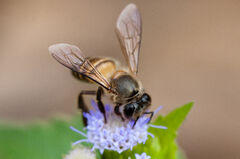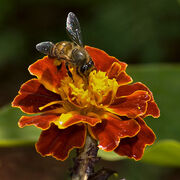| Apis cerana | |
|---|---|
 | |
| Scientific classification | |
| Kingdom: | Animalia |
| Phylum: | Arthropoda |
| Class: | Insecta |
| Order: | Hymenoptera |
| Family: | Apidae |
| Subfamily: | Apinae |
| Genus: | Apis |
| Subgenus: | (Apis) |
| Species: | A. cerana |
| Binomial name | |
| Apis cerana Fabricius, 1793 | |
Apis cerana, or the Asiatic honey bee (or the Eastern honey bee), are small honey bees of southern and southeastern Asia, including all the countries of the Himalayan region (Afghanistan, Bangladesh, Bhutan, China, India, Myanmar, Nepal, Pakistan) as well as Indonesia, Japan, Malaysia, Papua New Guinea, Thailand, and Vietnam, and probably other countries. This species is also known as the Himalayan hive honeybee[1]. This species is the sister species of Apis koschevnikovi, and both are in the same subgenus as the Western (European) honey bee, Apis mellifera.
It is still found in the wild, where it nests in tree holes, fallen logs, and crevices, but it is also one of the few bee species that can be domesticated. Like the Western honey bee, they are domesticated and used in apiculture, mostly in wooden boxes with fixed frames. Their size is similar or somewhat smaller than Apis mellifera, and they also have a more prominent abdominal stripes. Their honey yield is smaller, because they form smaller colonies. In folk medicine, their beeswax is used to treat and heal wounds.
Farmers in the Himalayan region benefit directly from honey and other bee products from Apis cerana which are a source of income, nutrition, and medicine. The bees are also important pollinators, ensuring the pollination of mountain crops, especially early flowering fruit and vegetables. It is available when temperatures are still too low for the exotic Apis mellifera species, and still flies under cool and cloudy conditions. As with other wild bees, Apis cerana also plays an important role in combating soil degradation by pollinating wild plants and ensuring that more biomass is available to be returned to the soil.
Beekeeping with Apis cerana has become an important source of income for mountain farmers, especially the poor and marginalised, as it is easy to practise. There is no capital outlay as the bee does not need to be fed, fumigated, or migrated to warmer areas in winter, and is mostly kept in traditional log hives[2]. It also produces high-quality honey and its wax is organic and natural.
Honey production is lower than for Apis mellifera, but is being increased through a focused queen breeding and selection programme.
The total number of Apis cerana colonies kept by farmers is unknown, but reports indicate an estimated 120,000 colonies in Nepal, and 1.5 million in the Himalayan region of China, about 780,000 of them in Yunnan province[3][4].
Apis cerana is the natural host to the mite Varroa jacobsoni and the parasite Nosema ceranae, both serious pests of the Western honey bee[5]. Having coevolved with these parasites, A. cerana exhibits more careful grooming than A. mellifera, and thus has an effective defense mechanism against Varroa that keeps the mite from devastating colonies. Other than defensive behaviors such as these, much of their behavior and biology (at least in the wild) is very similar to that of A. mellifera.
Workers do not re-use old wax as often as in other bee species and therefore their brood capping looks much lighter than those of Apis mellifera; they usually tear down old combs and build new wax constantly.
Apis cerana is found at altitudes from sea level up to 3,500 metres in areas with appropriate flora and climate. This bee species has adapted to adverse climatic conditions and can survive extreme fluctuations in temperature and long periods of rainfall. It is unique in its ability to survive temperatures as low as -0.1ºC, a temperature lethal for other bee species (Apis mellifera).
- Thermal defense: When an Apis cerana hive is invaded by the Japanese giant hornet (Vespa mandarinia), about 500 Japanese honey bees (A. cerana japonica) surround the hornet and vibrate their flight muscles until the temperature is raised to 47°C (117°F), heating the hornet to death, but keeping the temperature still under their own lethal limit (48-50°C). European honey bees (A. mellifera) lack this behavior.
Subspecies[]
(following Engel, 1999).
- Apis cerana cerana Fabricius ( = "sinensis") - Afghanistan, Pakistan, north India, China and north Vietnam
- Apis cerana heimifeng Engel
- Apis cerana indica - Fabricius South India, Sri Lanka, Bangladesh, Burma, Malaysia, Indonesia and the Philippines
- Apis cerana japonica Fabricius - Japan
- Apis cerana javana Enderlein
- Apis cerana johni Skorikov
- Apis cerana nuluensis Tingek, Koeniger and Koeniger
- Apis cerana skorikovi Engel ( = "himalaya") - Central and east Himalayan mountains (Ruttner, 1987)
Sources[]

Apis cerana from India
- Biodiversity of Honeybees, M. R. Srinivasan, Department of Agricultural Entomology - Tamil Nadu Agricultural University accessed Jul 2010
- Michael S. Engel (1999) The taxonomy of recent and fossil honey bees (Hymenoptera: Apidae: Apis). Journal of Hymenoptera Research 8: 165-196.
- ↑ Ahmad, Farooq; Joshi, S. R.; Gurung, M. B. (2003). The Himalayan Cliff Bee Apis laboriosa and the Honey Hunters of Kaski: Indigenous Honeybees of the Himalayas, Vol. 1 pp. 52. ICIMOD.
- ↑ Ahmad, Farooq; Joshi, S. R.; Gurung, M. B. (2007). Beekeeping and Rural Development. ICIMOD. Retrieved on 10/26/2007.
- ↑ Ken, Tan; Xuan, Zhang ; ShaoYu, He; DanYin, Zhou (2005). "Morphology and biogeography of Apis cerana (Fabr.) in China". Journal of Yunnan Agricultural University 20: 410-414.
- ↑ Ken, Tan; Fuchs, Stefan; Koeniger, Nikolaus; Ruiguang, Zan (2003). "Morphological Characterization Of Apis Cerana In The Yunnan Province Of China". Apidologie 34: 553–561. Template:Hide in printTemplate:Only in print. http://www.apidologie.org/articles/apido/pdf/2005/03/M4081.pdf. Retrieved October 17, 2007.
- ↑ Ritter, Wolfgang Nosema ceranae Albert Ludwigs University of Freiburg
External links[]
- Photos of Apis cerana
- Apis cerana' "cooking" a hornet to death - Video
- ICIMOD's Bees for livelihood program website
| https://upload.wikimedia.org/wikipedia/commons/9/98/Wikipedia_small_logo_rounded.png | This page uses Creative Commons Licensed content from Wikipedia (view authors). |